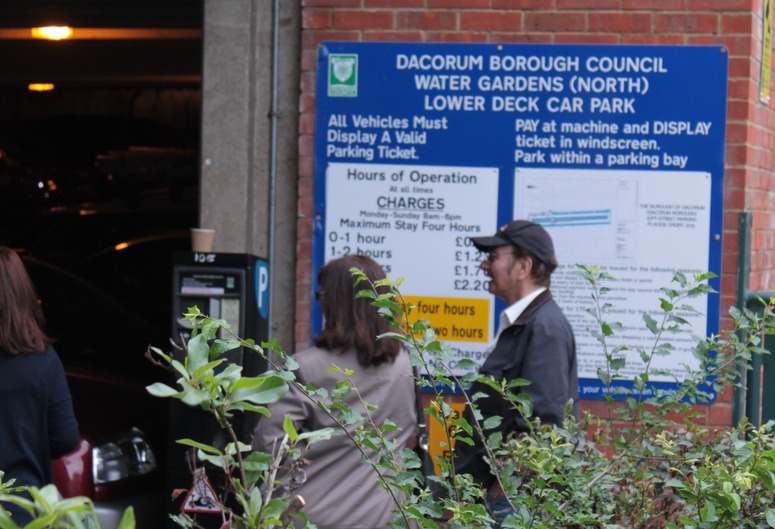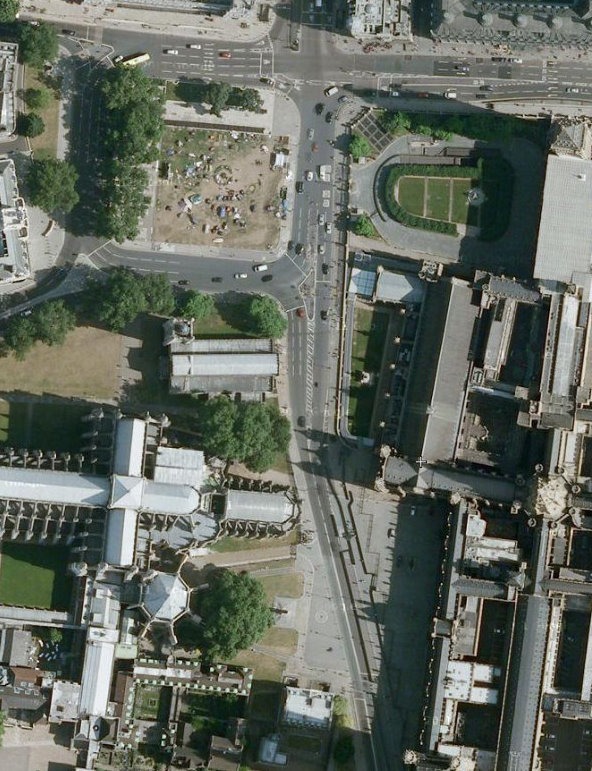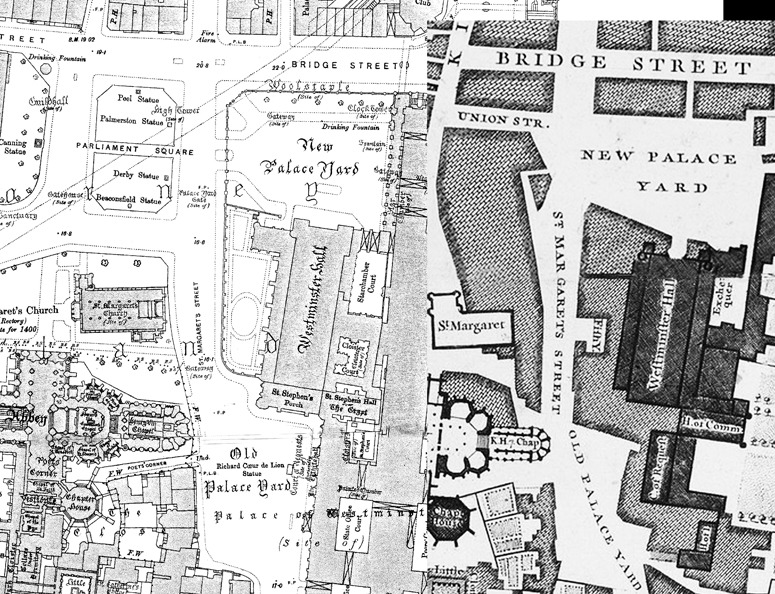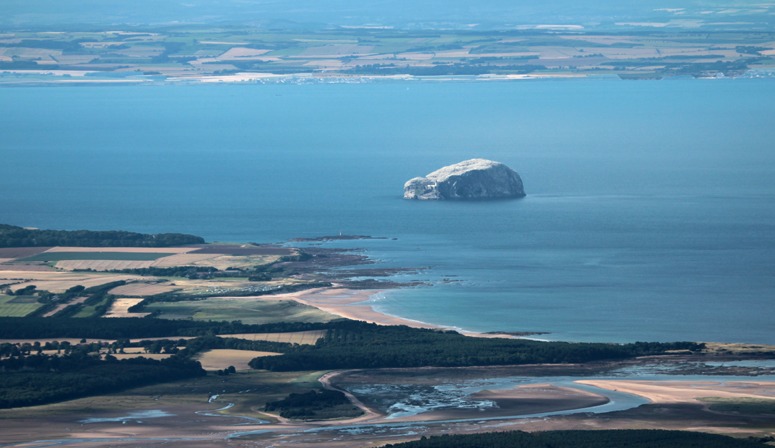 This delightful crocodile of children in a park was glimpsed while cycling to work. As I pressed the button it passed through my mind that one of the teachers might use a mobile phone to call the police to check out on a cycling photographer with an unhealthy interest in children.
This delightful crocodile of children in a park was glimpsed while cycling to work. As I pressed the button it passed through my mind that one of the teachers might use a mobile phone to call the police to check out on a cycling photographer with an unhealthy interest in children.
I rarely spend a day taking photographs in London without being told that the section of street on which I am standing is private property and photography is not allowed. In the rest of the world I can only remember being told not to take photographs on five occasions (including once in Japan and once in China). So London leads the world in something – albeit in a totally wrong direction.
Meanwhile I can guess what the policemen said when they arrested Rebekah Brooks today: ‘We are arresting you on suspicion of bribing us’ (or was it ‘I am arresting you on suspicion of bribing me?’ Rebekah was the chief executive of News International until last Friday. What destinies await these happy children?
Author Archives: Tom Turner
Hemel Hempstead Water Gardens are getting worse and worse and worse
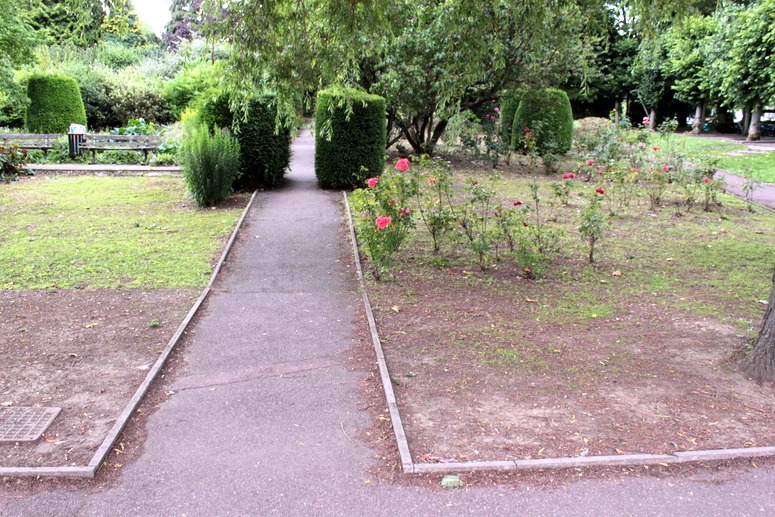
Is this a lawn, a rose garden or a slum? No. It is one of Susan Jellicoe's favourite planting designs - as 'managed' by Dacorum District Council
Geoffrey Jellicoe was an optimist. Susan, who did the planting design, was a pessimist. Their friend, Brenda Colvin, was even more of a pessimist. Remembering how many of her planting designs had been wrecked, Brenda Colvin remarked that ‘landscape architecture is a depressing profession – and the older you get the more depressing it gets’. As an optimist, I believe the Water Gardens will be restored. The Garden History Society held a 1-day conference about them last year. But the management needs to change. Why doesn’t Dacorum District Council use volunteers? Three of the truths to be universially acknowledged are (1) a volunteer is worth ten pressed men (2) two old ladies can maintain a garden more effectively than 10 well-equipped youths in green sweatshirts – because they know WHAT to do (3) in this world, you get more for love than you get for money.
Why don’t UK parks departments make more use of volunteers? It is very common in the US; it works well in Chiswick Park; it is normal practice in National Trust gardens. The reason, I wearily suppose, is that our trades unions do not like volunteers. They want more jobs for their own members. So the Hemel Hempstead Water Gardens can go to hell – or, better, they can extend the hellish car parks which have become the main ‘feature’ of the park since DDC took over from Hemel Hempsted Development Corporation. Parking costs about 60p/hour and they have 750 spaces, open 24 hours/day. If one assumes an occupancy of 30% then the weekly income (7x24x0.3×0.6×750) is £22,680. My suggestion is to give the £680 to the two old ladies, who would probably give it to a good cause.
Palácio da Alvorada, Brazil's Palace of the Dawn – and its garden design
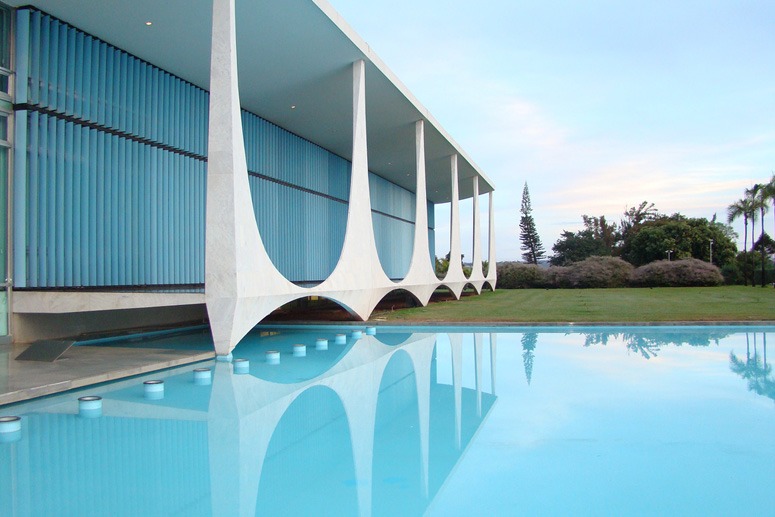
The home of the Brazil’s President was designed by Oscar Niemeyer and opened in 1958. Its name comes from Juscelino Kubitschek, who asked ‘What is Brasília, if not the dawn of a new day for Brazil?’ The design is wonderful. But is it perfect? ‘No’. The space looks sterile, the planting is deeply unimaginative and it is difficult to think of anything one might do with the space – except gaze at it.
Image courtesy Francisco Domingos
The landscape architecture of Parliament Square, Westminster, London UK
What alternitive functions might go towards a design brief for the re-design of Parliament Square: five star outdoor eating? a rose garden? the best fountain in London? a biodiversity garden? a carousel? a street market for pre-owned souveniers? a city farm? a waste-recycling facility? an outdoor art gallery? the best-kept lawn in Europe? floral bedding? a facility for the homeless? a collection of memorial sculptures? a permanent memorial to Brian Haw? Very obviously, the social role of Parliament Square must be considered before it can be re-designed.
From White-on-White to Green-on-Green: Suprematist landscape architecture and garden design
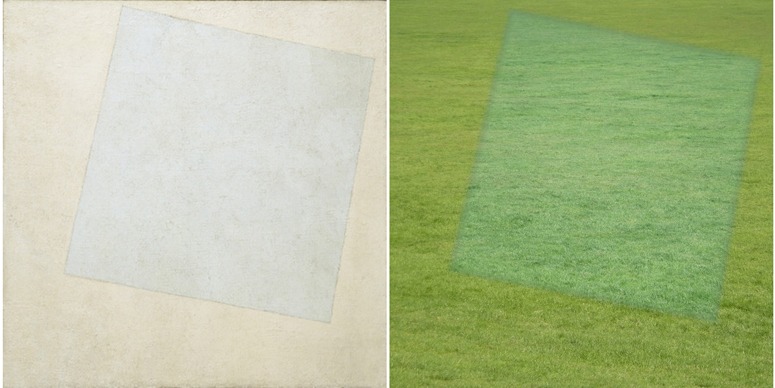 With the creditable exception of Burle Marx, and perhaps James Corner, landscape architects have been slow in responding to Suprematicism. Kasimir Malevich used this term as an alternative to Non-objective Art, which is itself an alternative to the more common Abstract Art. Malevich was thinking of its supremacy over previous art movements. Part of Malevich’s inspiration, like Corner’s, was from aerial photography: he abstracted patterns from landscapes. His suprematist ‘grammar’ was based on the elemental geometric forms, particularly the square and the circle. In the Eastern Orthodox tradition the holy family were believed to have a presence in icons. Comparably, a square is a square: it is not a picture of a square. This gives non-objective art a supremacy over representational (objective) art. Landscape architecture shares this type of supremacy over landscape painting: it is about making real places, not pictures of places. But landscape architects should also be fine artists in the sense of expressing truths about the nature of the world. Green-on-Green abstracts a truth about humanity’s relationship with the natural world: the works of man are always part of nature and always distinguishable from nature. We can guess that the term Abstract Art did not appeal to Malevich because of its use to mean ‘abstracted from the external world’. Malevich believed that art is spiritual. One can however, imagine that Malevich would have been happy to describe the ‘other’ type as Concrete Art, using concrete in the logician’s sense as an opposite to abstract.
With the creditable exception of Burle Marx, and perhaps James Corner, landscape architects have been slow in responding to Suprematicism. Kasimir Malevich used this term as an alternative to Non-objective Art, which is itself an alternative to the more common Abstract Art. Malevich was thinking of its supremacy over previous art movements. Part of Malevich’s inspiration, like Corner’s, was from aerial photography: he abstracted patterns from landscapes. His suprematist ‘grammar’ was based on the elemental geometric forms, particularly the square and the circle. In the Eastern Orthodox tradition the holy family were believed to have a presence in icons. Comparably, a square is a square: it is not a picture of a square. This gives non-objective art a supremacy over representational (objective) art. Landscape architecture shares this type of supremacy over landscape painting: it is about making real places, not pictures of places. But landscape architects should also be fine artists in the sense of expressing truths about the nature of the world. Green-on-Green abstracts a truth about humanity’s relationship with the natural world: the works of man are always part of nature and always distinguishable from nature. We can guess that the term Abstract Art did not appeal to Malevich because of its use to mean ‘abstracted from the external world’. Malevich believed that art is spiritual. One can however, imagine that Malevich would have been happy to describe the ‘other’ type as Concrete Art, using concrete in the logician’s sense as an opposite to abstract.
Geography and the origins of landscape architecture in Scotland
James Hutton lived 15 km south of the Bass Rock and used the geology of the region to support his Theory of the Earth, which argued that the Earth had evolved slowly, rather than being created in a week (as described in the Bible).
Gilbert Laing Meason invented the term ‘landscape architecture’, in 1828. Meason lived near Forfar (60 km north of the Bass Rock) which might be visible on the above photograph if it had been taken on a clearer day
John Claudius Loudon was the most prolific writer on gardens and architecture of his age. He designed some of the first public parks, proposed a system of Breathing Zones for London and transmitted the term ‘landscape architecture’ to Downing and Olmsted . Loudon spent his childhood at Gogar 40 km west of the Bass Rock
John Muir is regarded as the Father of America’s National Parks. John Muir was born in Dunbar (15 km from the Bass Rock) and the estuary in the foreground of the above photograph is now the John Muir Country Park.
Patrick Geddes, the first European to use ‘landscape architect’ as a professional title was the most innovative town and country planner of the twentieth century. Patrick Geddes was born near Perth (25 km north of the Bass Rock) and lived in Dundee and Edinburgh
Ian McHarg wrote the most influential landscape architecture book of the twentieth century (Design with nature) and contributed to the development of Geographical Information Systems (GIS) McHarg was born in Clydebank, 80 km west of the Bass Rock and near the boundary between the tectonic plates which were joined to make Britain
George Eliot wrote, in Adam Bede, that ‘a gardener is Scotch, as a French teacher is Parisian‘. She lived 1819–1880 and would have been on even stronger ground if writing about landscape architecture and planning!
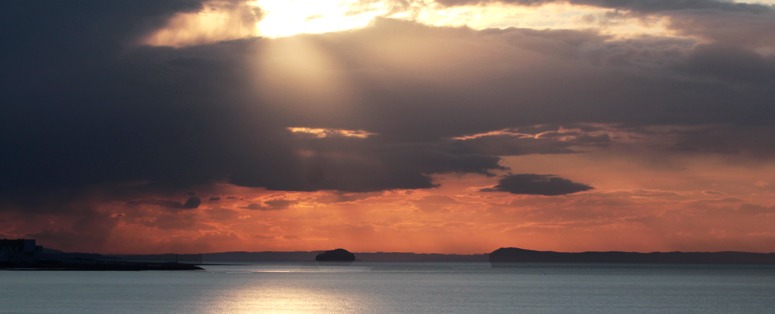
The Bass Rock (centre of photo) is one of many extinct volcanoes which form the landscape architecture of Scotland's Central Belt
See map history of How Britain was Formed. When the sun is setting (above) one gets a glimpse of how the region looked when the boundary between the Gondwana and Euramerica plates was full of volcanic activity, as Iceland is today, but the Devonian climate was hotter and drier.

